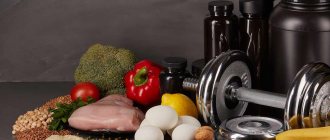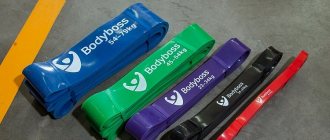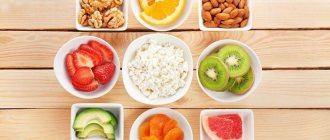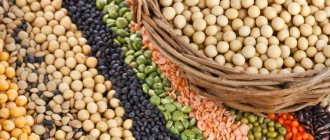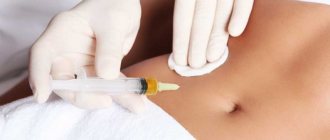MEASURING YOUR FAT PERCENTAGE USING A CALIPER.
A caliper is a device that measures the thickness of a fold of skin along with the subcutaneous layer of fat. By taking measurements at control points, you can accurately determine the total amount of fat in your body.
The photographs show the location of control points for measurements. Due to the location of some of them, you will need a helper to take the measurements. It is important to take measurements as close as possible to the locations shown in the photo instructions. This will allow you to measure your fat percentage with maximum accuracy.
Muscle
Many men are now engaged in creating the torso of Apollo from their bodies. Pumped up biceps and buttocks have become a cult in our time. And it’s not surprising, aesthetics is important for a person in everything, and our body is no exception.
So, we have already found out that fat will not develop into muscle. Then where can you get them from?
It is known that muscles grow from physical activity. But it is not so. The muscles themselves do not grow, but only slightly increase in volume. Without certain nutrition, muscle tissue will not grow larger.
HOW TO CORRECTLY MEASURE YOUR FAT PERCENTAGE USING A CALIPER
To correctly measure your body fat percentage, use the following instructions.
If you are right-handed, pull back the fold of skin with a layer of subcutaneous fat with the fingers of your left hand. Taking the caliper in your right hand, place the jaws of the device near the fold, as shown in the photo below. The caliper jaws should be approximately 7-9 mm from the fingers of the left hand, which hold the fold of skin. While still holding the crease with your left hand, slowly press the caliper platform with your right thumb until you hear a click. Stop pressing immediately after the click. Do not remove the fingers of your left hand while reading the readings.
It is important to hold the skin so that the caliper only measures the thickness of the folds. Stop pressing on the platform immediately after the click.
WE TAKE MEASUREMENTS AND CALCULATE THE PERCENTAGE OF SUBSCUTANEOUS FAT
Take measurements in all 4 places as shown in the photo below. Record the caliper readings. Now you can determine your body fat percentage using the table at the bottom of the page. Be careful - one table is for women, the other for men!
You will see that the data in the table does not contain millimeter sums or column values for each age group. If you build such a table, it will be very large. To determine exact values, it is necessary to interpolate the data.
For example, a woman in the 16-29 age group may have a total of 29 mm for four measurements. This is midway between 28 and 30 mm in the table. The fat percentage for 28 mm is 18.6%, and for 30 mm it is 19.5%. Interpolating between them will give approximately 19.0% ((19.5+18.6)/2).
Another example would be a 40-year-old man with a total of 42 mm for four measurements. Referring to the table of values for men, we find the values for 40 mm and 45 mm. 42 mm is 2/5 (0.4) in the range between 40 and 45 (45-40=5, 2/5=0.4). The fat % for 40mm is 20.3% and for 45mm it is 21.8%. Two-fifths of the interval from 20.3 to 21.8 is approximately 20.9% (((21.8-20.3)*0.4))+20.3)=20.9).
Why is muscle heavier than fat?
How much heavier muscle is than fat can be determined by its density. There are pictures on the Internet that clearly demonstrate how many times muscle tissue is heavier than fat. Usually this difference is amazing - a kilogram of fat is 4-5 times larger than the same amount of muscle. In fact, everything is greatly exaggerated.
Muscle tissue does weigh more than fat tissue, but not significantly. How much muscle is heavier than fat becomes clear in numbers:
- muscle density - 1.3 g per centimeter;
- The density of fat in the human body is about 0.9 g per centimeter.
Accordingly, fat weighs about one and a half times less than muscle. The difference is noticeable, but not as significant as many people think. So it turns out that if you started training, and the weight according to the scales remains the same, perhaps you are simply building muscle while burning calories. At the same time, body volumes remain almost unchanged or even decrease.
Because muscle weighs more than fat, women and men lose their figures over the years if they don't exercise. The fact is that the body weight of 45-50 years old may be the same as at 20-25 years old, but the build will be radically different. In youth, muscles predominate, and over the years, adipose tissue begins to grow, and it is always more difficult for mature people to burn fat.
Many people are mistaken that proper training can turn fat into muscle. This is a grave mistake. The fact is that fat and muscle are built in the body according to completely different principles. When playing sports, the level of fat gradually decreases, and muscles grow - these are two separate physiological processes, since the tissues have a different structure and structure.
HOW TO TAKE MEASUREMENTS
To accurately measure your body fat percentage, you need to take 4 measurements.
Triceps area:
Triceps area. Between the shoulder and elbow joints. The fold is taken in the middle of the back of the shoulder, vertically.
Biceps area.
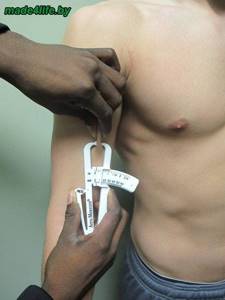
Biceps area. We take measurements in the same way as in the triceps area. We only form a fold in the middle of the shoulder on the front side.
Scapula area (back)
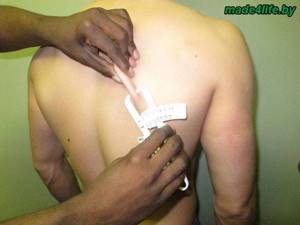
Back under the shoulder blade. The measuring location is just below the shoulder blade. Please note that the fold is taken at an angle of 45 degrees, as shown in the photo.
Waist
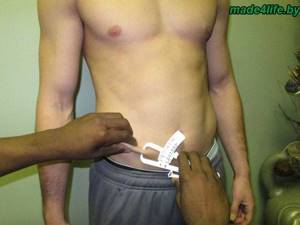
Waist. The location is just above the iliac crest, above the protrusion of the femur, slightly forward from the waist. The fold is formed almost horizontally, as shown in the photo.
What is heavier: fat or muscle mass: compare a kilogram of fat and a kilogram of muscle
It is wrong to think that kg of fat and kg of muscle are very different in volume. In fact, the figures are approximately the same. As proof, they cite a comparison of lard with meat - a kilogram of the former looks much larger than the same kilogram of the latter. In fact, their density is slightly different, so meat weighs about one and a half times more than lard.
Important!
If a person starts working out, and the scale needle suddenly suddenly stops, this does not mean that he has stopped losing weight, his muscles are just growing.
So, which is heavier, fat or muscle? Of course, muscles! During training, they grow, but the weight remains, although body volume decreases. If you don’t play sports, your figure will deteriorate with age, because in youth there is always more muscle tissue than fat. In adulthood, getting rid of excess fat is a difficult question, because fat cells do not transform into muscle cells.
Heavier muscles
TABLES TO CALCULATE YOUR BODY FAT PERCENTAGE.
Table for men.
| Table #1 - Men | |||
| % fat based on the sum of 4 measurements | |||
| Amount in mm | Age 16-29 | Age 30-49 | Age 50+ |
| 20 | 8,1 | 12,1 | 12,5 |
| 22 | 9,2 | 13,2 | 13,9 |
| 24 | 10,2 | 14,2 | 15,1 |
| 26 | 11,2 | 15,2 | 16,3 |
| 28 | 12,1 | 16,1 | 17,4 |
| 30 | 12,9 | 16,9 | 18,5 |
| 35 | 14,7 | 18,7 | 20,8 |
| 40 | 16,3 | 20,3 | 22,8 |
| 45 | 17,7 | 21,8 | 24,7 |
| 50 | 19,0 | 23,0 | 26,3 |
| 55 | 20,2 | 24,2 | 27,8 |
| 60 | 21,2 | 25,3 | 29,1 |
| 65 | 22,2 | 26,3 | 30,4 |
| 70 | 23,2 | 27,2 | 31,5 |
| 75 | 24,0 | 28,0 | 32,6 |
| 80 | 24,8 | 28,8 | 33,7 |
| 85 | 25,6 | 29,6 | 34,6 |
| 90 | 26,3 | 30,3 | 35,5 |
| 95 | 27,0 | 31,0 | 36,5 |
| 100 | 27,6 | 31,7 | 37,3 |
| 110 | 28,8 | 32,9 | 38,8 |
| 120 | 29,9 | 34,0 | 40,2 |
| 130 | 31,0 | 35,0 | 41,5 |
| 140 | 31,9 | 36,0 | 42,8 |
| 150 | 32,8 | 36,8 | 43,9 |
| 160 | 33,6 | 37,7 | 45,0 |
| 170 | 34,4 | 38,5 | 46,0 |
| 180 | 35,2 | 39,2 | 47,0 |
| 190 | 35,9 | 39,9 | 47,9 |
| 200 | 36,5 | 40,6 | 48,8 |
Table for women.
| Table #2 - Women | |||
| % fat based on the sum of 4 measurements | |||
| Amount in mm | Age 16-29 | Age 30-49 | Age 50+ |
| 14 | 9,4 | 14,1 | 17,0 |
| 16 | 11,2 | 15,7 | 18,6 |
| 18 | 12,7 | 17,1 | 20,1 |
| 20 | 14.1 | 18.4 | 21.4 |
| 22 | 15.4 | 19.5 | 22.6 |
| 24 | 16.5 | 20.6 | 23.7 |
| 26 | 17.6 | 21.5 | 24.8 |
| 28 | 18.6 | 22.4 | 25.7 |
| 30 | 19,5 | 23,3 | 26,6 |
| 35 | 21,6 | 25,2 | 28,6 |
| 40 | 23,4 | 26,8 | 30,3 |
| 45 | 25,0 | 28,3 | 31,9 |
| 50 | 26,5 | 29,6 | 33,2 |
| 55 | 27,8 | 30,8 | 34,6 |
| 60 | 29,1 | 31,9 | 35,7 |
| 65 | 30,2 | 32,9 | 36,7 |
| 70 | 31,2 | 33,9 | 37,7 |
| 75 | 32,2 | 34,7 | 38,6 |
| 80 | 33,1 | 35,6 | 39,5 |
| 85 | 34,0 | 36,3 | 40,4 |
| 90 | 34,8 | 37,1 | 41,1 |
| 95 | 35,6 | 37,8 | 41,9 |
| 100 | 36,3 | 38,5 | 42,6 |
| 110 | 37,7 | 39,7 | 43,9 |
| 120 | 39,0 | 40,8 | 45,1 |
| 130 | 40,2 | 41,9 | 46,2 |
| 140 | 41,3 | 42,9 | 47,3 |
| 150 | 42,3 | 43,8 | 48,2 |
| 160 | 43,2 | 44,7 | 49,1 |
| 170 | 44,6 | 45,5 | 50,0 |
| 180 | 45,0 | 46,2 | 50,8 |
| 190 | 45,8 | 46,9 | 51,6 |
| 200 | 46,6 | 47,6 | 52,3 |
NORMAL OR IDEAL FAT %?
It's not enough to just measure your fat percentage. Our main goal is to determine what is the correct or ideal body fat percentage? This is a rather complicated question. All people are different. It depends on age, gender and genetics. Some people feel better with a higher percentage of body fat, while others feel better with a lower percentage. Even among athletes, the percentage of subcutaneous fat can vary depending on the sport. For example, swimmers perform better at a higher body fat percentage than runners. But we can give you some general guidelines that apply to most people.
For men: For men under 30 years of age, the norm is in the range of 9-15%, from 30 to 50 years old - the norm is in the range of 11-17%, 50 years and older - 12-19%. It is advisable to be at or slightly below the upper end of the range; those towards the lower end can be described as lean.
For women: For women under 30 years old, the normal fat percentage is in the range of 14-21%, from 30-50 - 15-23%, from 50 to -16-25%. It is also better to be closer to the upper range or a little lower, being at the lower limit makes a woman look thin.
How much fat do we have?

Fat percentage plays a big role in determining your overall health and fitness level. This article will give a visual representation of what a certain amount of fat looks like on men and women. What should you know about your body fat percentage?
Body fat content is the amount of fat divided by a person's total weight and multiplied by 100, that is, converted to a percentage. For example, if a person has 15 kg of fat and weighs 90 kg, then (15/90) * 100 = 17% body fat. Body Fat Distribution – The distribution of body fat is very different from person to person. But, as a rule, there is a tendency for fat to accumulate in the abdominal area in men, and in the thighs and arms in women. Body Shapes – Due to the different distribution of fat in the body, the body shape is very different. Having completely different shapes, there may be the same percentage of fat. For example, a skinny man and a toned girl may have the same body fat percentage. Age – in the photographs in this article there are men and women aged 25-35 years. Most fat measuring devices will reflect a higher percentage of body fat as you age. For example, a 20-year-old man and a 50-year-old man may have unchanged levels of subcutaneous fat. However, as we age, fat around organs (visceral) and fat in muscles increases. And many meters catch this.
Fat percentage in men.
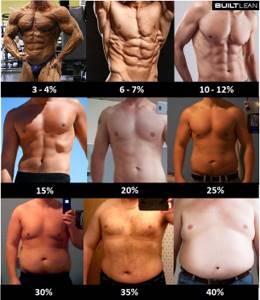
Men with a body fat percentage of 3-4% This amount of fat can be found in bodybuilders who are preparing for performances. They have very prominent blood vessels, on almost every muscle, and the muscles themselves are very separated. The body must retain 2% fat, this is the amount that is necessary for life and protects internal organs.
Men with a body fat percentage of 6-7% 6-7% body fat is not so extreme, but it is still almost impossible to maintain such a body fat percentage constantly. With this level of fat, your face becomes such that your family worries if you are okay. 6-7% body fat is reached by many fitness models when the muscles are very pronounced and blood vessels are already visible, for example in the arms.
Men with a body fat percentage of 10-12% With this percentage of fat, you can maintain your weight for a long time. This is the type of weight that many men strive for and most women enjoy. When the rectus abdominis muscle is highlighted, but not as much as with 6-7% fat.
A man with a body fat percentage of 15% With this percentage, there are muscle outlines, but there is no longer a clear separation. This form is also aesthetically beautiful and attractive.
A man with a body fat percentage of 20% The separation between muscles is almost blurred. Most men are in the 20-25% body fat range. At this percentage of fat, a tummy already appears a little, which is still soft and not round.
Men with a fat percentage of 25% The muscles no longer stand out. And from this percentage the waist begins to expand and increase. Already the waist volume may be slightly larger than the hip volume. After 25%, the stage of obesity begins, albeit the very first, but nonetheless.
Men with a body fat percentage of 30% There is already more fat in the body, which means it is distributed on the back, stomach, waist and hips. The stomach is already standing out forward. And the waist is much wider than the hips.
Men with a body fat percentage of 35% The more fat a man already has in his body, the more it is deposited in the abdominal area. The waist can already reach 102 cm with 35% body fat.
Men with a fat percentage of 40% The waist with this percentage of fat can already reach 114 cm. The stomach sticks out very much. Everyday activities like climbing stairs and tying shoelaces become increasingly difficult. This percentage of fat is characterized by obesity, in which the body mass index is 35.
Women's body fat percentage
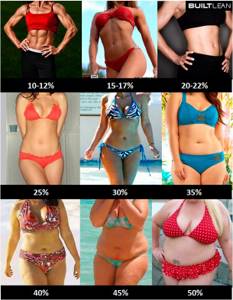
Women with a body fat percentage of 10-12% This is an extremely low body fat percentage that can only be found in female bodybuilders. The vital percentage of fat in women is 8-10%, in contrast to men with 2%. Why such difference? Women have more fat in the breast area and around the uterus. This level of fat is not considered safe or healthy in any case, as there is a risk that menstruation will disappear.
Women with a body fat percentage of 15-17% This is still a low body fat level for women, the same as 6-7% for men. Many fitness models and bikini misses reach this level of fat and may also experience problems with menstruation. The muscles are highly defined, separated and the blood vessels are clearly visible.
Women with a body fat percentage of 20-22% This body fat percentage is typical for most female athletes. There is already a percentage of fat on the arms and legs, but not too pronounced. The muscles are still visible and slightly separated.
Women with a fat percentage of 25% This is an average normal woman who doesn’t seem to be thin, but you can’t call her fat either. Fat is already, as a rule, localized in the hip area.
Women with a fat percentage of 35% Already the hips become wider and can approach 100 cm, and the waist to 81 cm. Already the stomach can protrude slightly forward.
Women with a body fat percentage of 40% Hips and waist grow even more. The hip circumference is already 114 cm, and the waist is 89 cm.
Women with a fat percentage of 45% The skin is already losing its smooth appearance, and more subcutaneous fat accumulates. Hips may become noticeably wider than shoulders.
Women with a fat percentage of 50% The skin is completely uneven and covered with bumps. The hips are much wider than the waist. The weight is completely unhealthy and normal life is difficult. This weight already affects the health of internal organs.
Knowing that there are many misconceptions about the amount of fat in the body, I hope these pictures have become a very clear motivation for you to take action. Be healthy!
HOW TO DETERMINE MUSCLE LOSS OR GROWTH
Once you have measured your body fat percentage, you have the ability to determine muscle loss or gain. You can find out your "lean mass" by measuring your body fat % and your body weight. Since muscle tissue is the component of lean mass that is most subject to change, changes in lean body weight are primarily changes in muscle weight.
First of all, you need to weigh yourself on an accurate scale. This will make it possible to calculate the weight of the dry mass. After a certain period of dieting or working on a training program, it is necessary to repeat the measurements. Changing body weight to account for changes in body fat percentage will help determine muscle gain and/or loss.
Example for men: A man weighs 95 kg. Fat percentage -30%. We multiply 95 kg by 30% and get 28.5 kg, this is the weight of fat contained in the body. We subtract 29 kg from 95 kg and determine that the dry weight is 66.5 kg. After a month of regular training and proper nutrition, his weight dropped to 88 kg. Fat percentage - up to 25%. We determine 25% of 88 kg and get 22 kg. This is the weight of body fat. Subtract this from the 88 kg body weight and find out that his dry mass is 66 kg. This means he lost 0.5kg of muscle mass while losing 6.5kg of fat. This is a very good result; and means that his diet and exercise program are working very well for him.
OVERVIEW OF CALCULATIONS PERFORMED:
Before: Fat content = 30% and Total weight = 95 kg 95*0.30 = 28.5 kg, 95-28.5 = 66.5 kg dry weight
After: Fat content = 25% and Total weight = 88 kg 88*0.25 = 22 kg, 88-22 = 66 kg dry weight
Result: 66.5 - 66 = 0.5 kg - reduction in lean mass 28.5 - 22 = 6.5 kg - loss of fat
Example for women: Starting weight 68 kg. Fat percentage -30%. Multiply body weight by 30% and get 20.4 kg of body fat. Subtract this value from 68 kg of body weight and get a dry mass of 47.6 kg. After a month of a low-calorie diet, my weight dropped by 9 kg. The total weight was 59 kg. New measurements showed 27% body fat. Again, we multiply the total weight by 27% (this is 15.9 kg of fat) and subtract it from body weight - we get 43.1 kg of dry mass. Thus, dry weight decreased by 4.5 kg. Fat loss - 4.5 kg. That is, during the diet, the woman lost as much muscle as fat. This means that the chosen diet is not very suitable for her and requires adjustment. It is also necessary to choose the right training program.
OVERVIEW OF CALCULATIONS PERFORMED:
Before: Fat content = 30% and Total weight = 68 kg 68*0.30 = 20.4 kg, 68-20.4 = 47.6 kg dry weight
After: Fat Content = 27% and Total Weight = 59 kg 59*0.27 = 15.9 kg, 59-15.9 = 43.1 kg dry weight
Result: 47.6 - 43.1 = 4.5 kg - decrease in lean mass 20.4 - 15.9 = 4.5 kg - loss of fat
For those who have lost muscle and gained fat over years of inactivity, I can actually increase muscle mass while losing excess fat. For example, a 68-year-old man, 70 kg. Caliper measurements showed 28% fat. This is 19.6 kg of fat and 50.4 kg of dry mass. He has been exercising regularly for 4 months, including lifting weights, and following a healthy diet. After 4 months he weighs 68 kg. Fat percentage dropped to 18%. Multiplying the weight by the percentage of fat we get 12.2 kg of fat. Subtract this value from 68 kg and get 55.8 kg. Dry weight increased by 5.4 kg. In other words, the man gained 5.4 kg of muscle mass previously lost and lost 7.4 kg of fat.
OVERVIEW OF CALCULATIONS PERFORMED:
Before: Fat content = 28% and Total weight = 70 kg 70*0.28 = 19.6 kg, 70-19.6 = 50.4 kg dry weight
After: Fat content = 18% and Total weight = 68 kg 68*0.18 = 12.2 kg, 68-12.2 = 55.8 kg dry weight
Result: 55.8 - 50.4 = 5.4 kg - height dry weight 19.6 - 12.2 = 7.4 kg - fat loss
Why does a person need fat?
Adipose tissue has a huge range of functions. Yes, in fact, fat is not an enemy, but your best friend. It is this that will indirectly contribute to the growth of muscle mass in the future. No, this does not mean that 1 kg of fat = kg of muscle after several workouts. No! Fat will release its energy reserves for hard training, which will be aimed at growing muscle mass.
By the way, this is not the only function of adipose tissue. For example, the hormone leptin is involved in metabolism.
It is also important to take into account that it is not always useful to be “relief”. Yes, undoubtedly, for many it looks very beautiful. But the female body is not characterized by relief at all. And a lack of fat can negatively affect women's health.
Below you can see what a kilogram of fat looks like.
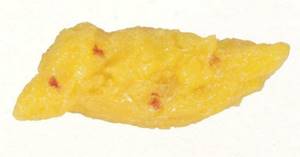
HOW TO DETERMINE YOUR IDEAL WEIGHT AT YOUR DESIRED FAT PERCENTAGE

If you know your weight and were able to accurately measure your body fat percentage, you can determine what your weight should be for any percentage of subcutaneous fat. This can be done using simple calculations. Subtract your existing body fat % from 100 and divide that value by 100 minus your desired body fat %. Multiply this by your current weight to give you your desired body fat percentage. For example, a woman weighs 65 kg, her body fat percentage is 32%. She wants to reduce her body fat to 21% and wants to know how much she will weigh. Subtract 32 from 100, we get 68. Subtract 21 from 100, we get 79. Divide 68 by 79 - equals 0.86. We multiply 65 kg by 0.86 - we get the desired weight of 56 kg.
That is, to reduce body fat to 21%, she must lose 9 kg. IMPORTANT - the above formula only works if a person loses excess weight in such a way as to preserve muscle tissue. This can be done with proper training and a balanced diet. If you lose weight primarily through a low-calorie diet over a short period of time, then muscle tissue will also be lost, and then your ideal weight based on your desired body fat percentage will be correspondingly less.
Fat in women and men
As you know, women and men are built completely differently. Including, fat deposition in female and male bodies occurs differently.
In women, fat is usually stored on the thighs. Its function is to save energy for the lactation period and ensure the feeding of the baby. This fat is very difficult to lose. And during breastfeeding, it becomes more pliable and comes off easier.
In men, fat is deposited mostly in the abdominal area. Men generally have a much easier time losing weight than women.
It is also important that the latter are much more impressionable than men and are very sensitive to their bodies. The girl will quickly notice the extra kilogram on her body.
Men don’t worry at all about how a kilogram of fat looks on their body. Moreover, they often do not see changes in their body even by ten kilograms.
For clarity, you can go back and remember what 1 kg of fat looks like. The photo is presented above in the article.

